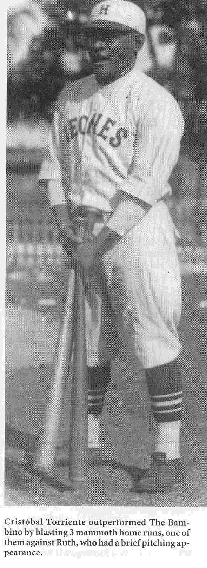
Thousands of articles!
Also
Read: ![]() For
what is history but a myth agreed upon (Jackie Robinson, Rickey,
Wilkinson)?
For
what is history but a myth agreed upon (Jackie Robinson, Rickey,
Wilkinson)?
THE OTHER HALF OF BASEBALL HISTORY
John B Holway
I've often said that some of the best baseball in America was played between
the World Series and Opening Day.
These were the many black/white post-season barnstorming games and
the winter leagues in Cuba and California.
Two new books have now filled in worlds of data from the rich history
of the latter two. They are
Cuban
Baseball by Jorge Figueredo and The California Winter Leagues
by William McNeil, both published by
McFarland.
Before Castro the Cuban League was as strong as the Negro Leagues,
because it included the best black players, plus some whites, both Cuban
and North American, from the National and American Leagues, all concentrated
in only three or four clubs.
Some of the top teams in the States barnstormed in Cuba –Chief
Bender and the 1909 A’s, Ty Cobb and the 1910 Tigers, Christy Mathewson
and the 1911 Giants, Carl Hubbell and the 1933 Giants, the 1942 Dodgers
etc. They lost more than they won.
Little Jose Mendez, whose pitching arm was hardened by a childhood
of chopping sugar cain, gave the Americans their first shock in 1908, when
he threw a one-hitter at the Cincinnati
Reds. The only hit was a scratch
by the first batter, future Yankee skipper Miller Huggins, a roller to the
infield when Mendez himself failed to cover first.
The next year the Tigers arrived, sans Cobb and Sam Crawford,
and were beaten seven out of 11 games.
Eustaquio “Derby Hat” Pedroso threw an 11-inning no-hitter
at them. The Sporting News called it a “disaster,”
the Reach Guide called it a
“disgrace.”
The next year the Tigers returned, this time with Cobb and Crawford
and restored their lost pride.
Cobb, the American League batting and stolen base champ, batted .369,
but was outhit by three U.S. blacks – John Henry Lloyd, Home Run Johnson,
and Bruce Petway. He stole no
bases against Petway and Strike Gonzalez and stomped off the field, vowing
never to play blacks again, and he didn’t.
 In 1911 the Giants arrived.
Perhaps spending too much time in the fleshpots of Havana, they lost
badly until manager John McGraw stormed that he’d send anyone who
wasn’t playing hard home on the next
boat. The Giants bet their paychecks
on themselves and won the next few games before Mendez and Pedroso combined
to beat the great Mathewson 9-6.
In 1911 the Giants arrived.
Perhaps spending too much time in the fleshpots of Havana, they lost
badly until manager John McGraw stormed that he’d send anyone who
wasn’t playing hard home on the next
boat. The Giants bet their paychecks
on themselves and won the next few games before Mendez and Pedroso combined
to beat the great Mathewson 9-6.
Mac thirsted to sign some of the black star he
found. He did sign one, pitcher
Adolfo Luque, who was white, and went on to win 197 games in the National
League.
No white big league clubs made the trip in the 1920s, but the Cuban
League remained a powerhouse. The
1923-24 Santa Clara Leopards are compared to the 1927
Yankees.
They starred possibly the greatest outfield of all time – Pablo
“Champion” Mesa (.328), Oscar Charleston (.379), and Alejandro
Oms (.381). Oms, one of the
most under-rated hitters in North American history, had a lifetime average,
in Cuba and the States, to rival Jud Wilson and Cobb as one of the three
top pure average hitters in the game.
The infield was also one of the best in any
league: first base Heavy Johnson (.345), second base Frank Warfield
(.296), shortstop Dobie Moore (.386), and third base Oliver Marcelle
(.292).
Their catchers were two top defensive stars, Julio Rojo, and Frank
Duncan, Jackie Robinson’s first
manager.
The pitching staff was Bill Holland (10-1), Rube Currie (8-2), left-hander
Dave Brown (7-3), and the aging Mendez (3-1).
If U.S. baseball had been integrated, I have no doubt that all or
most of these would be in Cooperstown today.
They bowled over the rest of the league, including the Havana Reds,
who starred Luque (7-3), Lloyd (.305), and Cristobal Torriente
(.366).
I regard Torriente as the best player to come out of Cuba, better than
Hall of Famer Martin Dihigo. Torri
hit better, with more power, won almost as many games in the States as a
pitcher, was one of the game’s top centerfielders, and even played a
little third base – left-handed.
Dick Lundy “King Richard,” who may have topped Lloyd as the
Negro leagues’ best shortstop, played for the third-place Almendares
Blues and batted .331.
Freddie Fitzsimmons, the future Giant and Dodger pitcher, and Chuck Dressen,
future Dodger manager, played for Marianao, which finished
last.
These are only some of the highlights of this monumental, meticulously
researched, and copiously illustrated
book. Figueredo has unlocked
some of the best-kept secret chapters of baseball history.
I'll have a report on Bill McNeil’s equally valuable book in a future
posting.